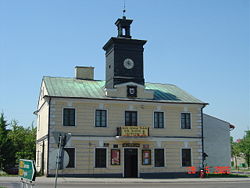Sierpc
| Sierpc | |||
|---|---|---|---|

Old town hall
|
|||
|
|||
| Coordinates: 52°53′N 19°40′E / 52.883°N 19.667°E | |||
| Country |
|
||
| Voivodeship | Masovian | ||
| County | Sierpc County | ||
| Gmina | Sierpc (urban gmina) | ||
| Established | 10th century | ||
| Town rights | 1322 | ||
| Government | |||
| • Mayor | Jarosław Perzyński | ||
| Area | |||
| • Total | 18.6 km2 (7.2 sq mi) | ||
| Population (2006) | |||
| • Total | 18,791 | ||
| • Density | 1,000/km2 (2,600/sq mi) | ||
| Time zone | CET (UTC+1) | ||
| • Summer (DST) | CEST (UTC+2) | ||
| Postal code | 09-200 | ||
| Area code(s) | +48 024 | ||
| Car plates | WSE | ||
| Website | http://www.sierpc.pl | ||
Sierpc [ɕerpt͡s] is a town in Poland, in the north-west part of the Masovian Voivodeship, about 125 km northwest of Warsaw. It is the capital of Sierpc County. Its population is 18,777 (2004). It is located near the national road No 10, which connects Warsaw and Toruń. Sierpc is a rail junction of local importance, where two lines cross: Kutno - Brodnica, and Nasielsk - Toruń.
Among the most important dates in Sierpc history there are:
It is an open-air museum and is located in the suburbs of Sierpc in the valley of the Sierpienica River and its confluence with the Skrwa Prawa. Though it looks like a separate and independent village because of its great area (about 60.5 hectares) and because it is fenced, the museum is included within the town's borders. The village is made up of 11 farms (houses - cabins, barns, cowsheds, granaries, pigsties), an inn, a blacksmith's workshop, an oil - mill, a windmill, a manor house, a small chapel and a wooden church. Everything was collected from different regions of Masovia. The architecture of houses reminds that from 19th or early 20th century. Also inside the houses there are pieces of furniture, utensils, equipment and hand-made decorations which are appropriate to the epoch. Each season there are exhibitions devoted to traditional Masovian customs i.e. "Christmas in Mazovie Region", "Easter in Mazovie Region". Also children can find something interesting for them : "Palm Sunday in Skansen museum", "Sunday in Skansen museum", "Cooking in the middle of the glade", "Children's Day in Skansen museum", "Honey harvest in Skansen museum" or "Harvest season in Skansen museum".
A few movies have used the museum as a location. The most famous are: Pan Tadeusz, Ogniem i mieczem and Szwadron.
...
Wikipedia



